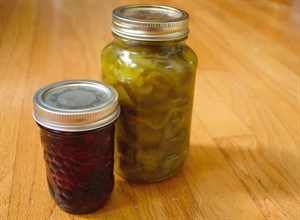
Raspberry Jam and bread and butter pickles preserves are pictured on Wednesday July 30, 2014.
Image Credit: THE CANADIAN PRESS/Megan Cole
August 01, 2014 - 12:18 PM
VICTORIA - Cleaning out kitchen cupboards and the pantry often means tossing items that are near their best-before dates. But instead, creative home cooks can transform such produce and canned goods into delicious preserves.
Serena Chu, who teaches canning workshops in Vancouver for Save-On-Meats and Skipper Otto, began canning as a way to use produce that was destined for the compost heap.
While helping sell organic produce at a Vancouver farmers market, Chu was given access to a bounty of produce that couldn't be sold to customers.
"That's how I started. I saw that it would go in the garbage or I could take it, and put it in jars," she says. "I just started canning everything after that."
After getting food-safe certifications in addition to doing a wide variety of research into the most up-to-date and approved canning methods, Chu began teaching others to preserve not only the harvest from their own gardens, but also other local, seasonal produce.
"It is important for people to know what is in their food," she says. "The two most important things about it is it's more cost effective and it tastes better. It educates people to eat seasonally."
Having a pantry stocked with homemade canned goods means instead of buying tomatoes in the dead of winter when Chu says they are "anemic and gross," homeowners have access to local produce all year.
While Chu says it is easiest to learn about canning through workshops and classes, she says there is a lot of great information both online and in library books, but be wary of food safety.
"There is a lot of information on the web and there are also a lot of inconsistencies because people who don't take proper food safety courses post things online," she cautions. "Picking up the USDA (U.S. Department of Agriculture) food safe guides is a great source along with manufacturers of jars or canning equipment are another good resource because all their recipes are lab tested because it goes with their brand, so it has to be in line with the USDA format anyhow."
In addition to stocking kitchen cupboards with home-canned vegetables and other preserves, many homeowners are also filling their fridges with fermented products, from pickles to sauerkraut.
As with canning, fermentation is an easy and cost-effective way to preserve seasonal produce, especially because most people already have the equipment in their home.
"Fermentation requires things that you most likely already have in your kitchen," says Geri Soulliere, talent sprout at Fresh City in Toronto. "We all have jarred stuff in our fridge all the time, and I just don't throw those out any more. Big or small I save them."
Besides jars, Soulliere says the only things you need for successful fermentation are vegetables, salt, a bowl to mix it all in and a crock for large batches.
Soulliere began fermenting when Fresh City, an organization that grows and distributes organic produce, was introducing fermentation workshops to the classes they were already offering.
"When I started organizing the workshops last year I learned a lot about it," she says. "Over the winter I started doing my own ferments. What I learned is that you can ferment any vegetable. Some taste better than others and radishes were my favourite."
As Soulliere was accumulating a lot of radishes from the Fresh City farm because of a large harvest, she decided to try to ferment them.
"I thought, 'let's see how they ferment,' and they almost came out like a healthy potato chip," she says. "They are a nice crunch snack and they are really good for you. It was incredible how they mellowed out the heat of a radish, and it brought out this beautiful flavour."
Fermentation, like canning, is easy to learn. As well as there being a lot of workshops and classes available, Soulliere says there are many great resources online and through the library.
News from © The Canadian Press, 2014